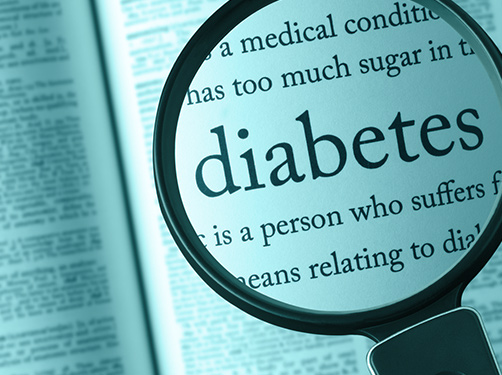What is gestational diabetes?
Scientific support: PD Dr. Sandra Hummel
Pregnancy changes a woman's metabolic hormone balance. This can affect her metabolism and drive up her blood glucose levels. If these persistently go beyond a certain threshold, this is called gestational diabetes.
Women do not usually have symptoms with gestational diabetes. For this reason it is important to do a blood glucose test (glucose tolerance test) between weeks 24 and 28 of the pregnancy to detect and treat the disease early on. It is only when blood glucose levels are significantly elevated that symptoms such as fatigue and severe thirst develop.

From the 20th week of pregnancy various hormones flood the pregnant woman’s body. They change physical processes to allow the unborn child to grow. Glucose metabolism also adjusts so that more blood glucose can reach the child through the umbilical cord.
If the blood glucose values persistently exceed a certain threshold, the woman has gestational diabetes. High blood sugar levels can have short term and long term consequences for the mother and child. This is why it is important to identify and treat gestational diabetes at an early stage. In most women, glucose metabolism returns to normal after the child is born.
Gestational diabetes, like type 2 diabetes, is an interplay between increased insulin resistance and limited insulin release.
Good to know:
Gestational diabetes is a metabolic disorder that is diagnosed for the first time in pregnancy. It then often disappears after pregnancy.
Contents
1. How common is gestational diabetes?
The analysis of data from a large German health insurance company reveals that over the years, an increasing number of women have been diagnosed with gestational diabetes. In 2010, it was about 9 out of 100 pregnant women (9 percent), and by 2020, it had risen to 15 out of 100 pregnant women (15 percent). Researchers believe that this trend may be primarily associated with the growing number of older and overweight pregnant women – two significant risk factors for elevated blood sugar during pregnancy.
2. Does gestational diabetes have symptoms?
Gestational diabetes does not cause any symptoms in many cases. It is only when blood glucose values rise too high that symptoms seen in other types of diabetes develop:
- Weakness
- Fatigue
- Increased thirst
- Increased urination
These symptoms are often confused with normal symptoms of pregnancy. Regular medical check-ups and blood glucose tests for gestational diabetes are therefore all the more important. Other signs are repeated evidence of glucose in urine or increased levels of amniotic fluid.
Good to know:
Pregnant women rarely notice that their blood glucose is high. A glucose tolerance test can check if a woman has gestational diabetes.
3. Who gets gestational diabetes?
Women who are overweight or have an older gestational age are particularly susceptible to gestational diabetes. Among other factors, belonging to certain ethnic groups also increases the risk for the metabolic disorder.
Read detailed information about the development of gestational diabetes and the risk factors here.
4. Preventing gestational diabetes
Being overweight and gaining excess weight gain during pregnancy make it more likely for a woman to develop gestational diabetes. It is therefore recommended that women minimize both risk factors with a healthy lifestyle. The latest research is centered around which women benefit most from lifestyle intervention. Instead of one-size-fits-all recommendations on lifestyle during pregnancy, individual risk factors and habits shall in future be taken into account.
Good to know:
After the birth, women with gestational diabetes should continue to remain active. This is because the risk of developing type 2 diabetes over the next years is increased.
Further information on gestational diabetes
Sources:
Ahlqvist, E. et al.: Novel subgroups of adult-onset diabetes and their association with outcomes: a data-driven cluster analysis of six variables. In: Lancet Diabetes Endocrinol, 2018, 6: 361-369
American Diabetes Association: 2. Classification and Diagnosis of Diabetes: Standards of Medical Care in Diabetes - 2023. In: Diabetes Care, 2023, 46: S19-S40
Bundesärztekammer et al.: Nationale Versorgungsleitlinie Typ-2-Diabetes. Langfassung. Version 3.0. 2023
Landgraf, R. et al.: Definition, Klassifikation, Diagnostik und Differenzialdiagnostik des Diabetes mellitus: Update 2022. In: Diabetologie, 2022, 17: S98-S110
Landgraf, R. et al.: Therapie des Typ-2-Diabetes. In Diabetologie, 2022, 17: S159-S204
Lean, M. E. J. et al.: Durability of a primary care-led weight-management intervention for remission of type 2 diabetes: 2-year results of the DiRECT open-label, cluster-randomised trial. In: Lancet Diabetes Endocrinol, 2019, 7: 344-355
Zaharia, O. P. et al.: Risk of diabetes-associated diseases in subgroups of patients with recent-onset diabetes: a 5-year follow-up study. In: Lancet Diabetes Endocrinol, 2019, 7: 684-694
As of: 28.12.2023




